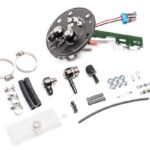The automotive world is rapidly embracing electric vehicles (EVs), and the 2024 model year is seeing a surge in impressive electric SUVs. As these vehicles become more common, understanding their unique maintenance needs is crucial for owners. While EVs generally require less maintenance than their gasoline counterparts, certain aspects of their upkeep are essential to ensure longevity and optimal performance. This guide will delve into the key maintenance considerations for 2024 EV SUVs, helping you stay informed and keep your electric SUV running smoothly for years to come.
Understanding EV SUV Maintenance: Key Differences
Electric SUVs, unlike traditional internal combustion engine (ICE) vehicles, operate with significantly fewer moving parts. This fundamental difference translates to a different maintenance landscape. You can say goodbye to oil changes, spark plug replacements, and exhaust system checks. However, this doesn’t mean EVs are maintenance-free. Instead, the focus shifts to other critical components.
Battery Care and Longevity
The battery pack is the heart of any EV, and its health is paramount. For 2024 EV SUVs, battery technology is advanced, but proper care remains vital for maximizing lifespan and range.
- Charging Habits: Avoid consistently charging to 100% and depleting to 0%. Ideally, keep the battery charge between 20% and 80% for daily use to minimize stress on the battery. Refer to your 2024 EV SUV’s manual for specific recommendations.
- Temperature Management: Extreme temperatures, both hot and cold, can impact battery performance and longevity. Utilize pre-conditioning features when available to optimize battery temperature before driving and charging, especially in harsh climates. Parking in shaded areas or garages can also help.
- Software Updates: Manufacturers often release software updates that can improve battery management, charging efficiency, and overall vehicle performance. Ensure your 2024 EV SUV receives these updates promptly.
Tire Maintenance: Rotation and Condition
Tires on EVs, especially SUVs, can experience different wear patterns due to instant torque and vehicle weight. Regular tire maintenance is crucial for safety, efficiency, and tire longevity.
- Tire Rotation: Follow the recommended tire rotation schedule in your owner’s manual. Rotating tires helps ensure even wear and extends their lifespan. For many 2024 EV SUVs, this is typically recommended every 5,000 to 7,500 miles.
- Tire Pressure: Maintain proper tire pressure as specified on the tire sidewall or doorjamb sticker. Correct pressure optimizes handling, braking, and range. EVs often have specific tire pressure recommendations to account for their weight.
- Tire Condition: Regularly inspect your tires for wear and tear, including tread depth, sidewall damage, and uneven wear patterns. Replace tires when tread depth is low or damage is evident. Consider EV-specific tires designed for the torque and weight of electric SUVs for optimal performance and efficiency.
Brake System: Less Wear, Continued Attention
EVs utilize regenerative braking, which significantly reduces wear on traditional brake pads and rotors. However, the brake system still requires periodic checks.
- Brake Fluid Checks: Brake fluid should be checked and replaced according to the manufacturer’s schedule, typically every 2-3 years, as it can absorb moisture over time, affecting braking performance.
- Brake Caliper and Rotor Inspection: While wear is reduced, calipers and rotors should still be inspected periodically for corrosion, damage, and proper function, especially in regions with road salt.
- Parking Brake Maintenance: Ensure the parking brake is functioning correctly. Some EVs have electronic parking brakes that may require specific maintenance procedures.
Cabin Air Filter Replacement
Like all vehicles, 2024 EV SUVs have cabin air filters that clean the air entering the passenger compartment.
- Regular Replacement: Cabin air filters should be replaced at recommended intervals, typically every 12,000 to 15,000 miles, or more frequently in dusty or polluted environments. A clogged cabin air filter can reduce airflow and impact the efficiency of the climate control system.
Windshield Wipers and Washer Fluid
Maintaining visibility is crucial for safety.
- Wiper Blade Replacement: Replace windshield wiper blades when they become streaky or ineffective, usually every 6-12 months, depending on usage and climate.
- Washer Fluid Top-Up: Regularly check and top up windshield washer fluid to ensure clear visibility in all weather conditions.
Coolant System Checks (Battery and Thermal Management)
EVs often have coolant systems for battery thermal management and other components.
- Coolant Level and Condition: Check coolant levels periodically and ensure the coolant is in good condition. EV-specific coolant may be required. Follow the manufacturer’s recommendations for coolant changes.
Finding Service for Your 2024 EV SUV
As EV technology evolves, so does the service infrastructure.
- Authorized Dealerships: Start with authorized dealerships for your EV SUV brand. They have trained technicians and specialized equipment for EV maintenance and repairs.
- Certified EV Technicians: Look for service centers with certified EV technicians. Certification ensures technicians have the necessary training and expertise to work on electric vehicles.
- Independent EV Repair Shops: Independent repair shops specializing in EVs are becoming more common. Check online reviews and certifications to ensure they are reputable and qualified.
The Long-Term Maintenance Picture for 2024 EV SUVs
Owning a 2024 EV SUV can offer long-term maintenance savings compared to traditional gasoline SUVs due to fewer moving parts and reduced wear on certain components. However, proactive maintenance and attention to the specific needs of EVs are essential. By understanding these key maintenance areas and following recommended service schedules, you can ensure your 2024 electric SUV remains reliable, efficient, and enjoyable for many years to come.
